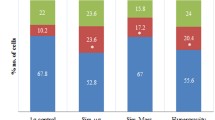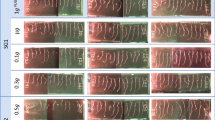Abstract
Ground-Based Facilities (GBF) are essetial tools to understand the physical and biological effects of the absence of gravity and they are necessary to prepare and complement space experiments. It has been shown previously that a real microgravity environment induces the dissociation of cell proliferation from cell growth in seedling root meristems, which are limited populations of proliferating cells. Plant cell cultures are large and homogeneous populations of proliferating cells, so that they are a convenient model to study the effects of altered gravity on cellular mechanisms regulating cell proliferation and associated cell growth. Cell suspension cultures of the Arabidopsis thaliana cell line MM2d were exposed to four altered gravity and magnetic field environments in a magnetic levitation facility for 3 hours, including two simulated microgravity and Mars-like gravity levels obtained with different magnetic field intensities. Samples were processed either by quick freezing, to be used in flow cytometry for cell cycle studies, or by chemical fixation for microscopy techniques to measure parameters of the nucleolus. Although the trend of the results was the same as those obtained in real microgravity on meristems (increased cell proliferation and decreased cell growth), we provide a technical discussion in the context of validation of proper conditions to achieve true cell levitation inside a levitating droplet. We conclude that the use of magnetic levitation as a simulated microgravity GBF for cell suspension cultures is not recommended.






Similar content being viewed by others
References
Barjaktarović, ž., Nordheim, A., Lamkemeyer, T., Fladerer, C., Madlung, J., Hampp, R.: Time-course of changes in amounts of specific proteins upon exposure to hyper-g, 2-D clinorotation, and 3-D random positioning of Arabidopsis cell cultures. J. Exp. Bot. 58, 4357–63 (2007)
Beaugnon, E., Tournier, R.: Levitation of organic materials. Nature 349, 470 (1991)
Berry, M.V., Geim, A.K.: Of flying frogs and levitrons. Eur. J. Phys. 18, 307–13 (1997)
Boonsirichai, K., Guan, C., Chen, R., Masson, P.H.: Root gravitropism: an experimental tool to investigate basic cellular and molecular processes underlying mechanosensing and signal transmission in plants. Annu. Rev. Plant Biol. 53, 421–47 (2002)
Brooks, J.S., Reavis, J.A., Medwood, R.A., RA, Stalcup T.F., Meisel, M.W., et al.: New opportunities in science, materials, and biological systems in the low-gravity (magnetic levitation) environment (invited). J. Appl. Phys. 87, 6 (2000)
Buffett, B.A.: Tidal dissipation and the strength of the Earth’s internal magnetic field. Nature 468, 952–4 (2010)
Christianen, P.C.: Tuneable gravity using strong gradient magnetic fields. News of Elgra 7, 4 (2010)
Denegre, J., Valles, J.J., Lin, K., Jordan, W., Mowry, K.: Cleavage plans in frogs eggs are altered by strong magnetic fields. Proc. Natl. Acad. Sci. 95, 14729–32 (1998)
Dijkstra, C.E., Larkin, O.J., Anthony, P., Davey, M.R., Eaves, L., et al.: Diamagnetic levitation enhances growth of liquid bacterial cultures by increasing oxygen availability. J. R. Soc. Interface 8, 334–44 (2011)
Geim, A.K., Simon, M.D., Boamfia, M.I., Helfinger, L.O.: Magnet levitation at your fingertips. Nature 400, 2 (1999)
Glover, P.M., Cavin, I., Qian, W., Bowtell, R., Gowland, P.A.: Magnetic-field-induced vertigo: a theoretical and experimental investigation. Bioelectromagnetics 28, 349–61 (2007)
González-Camacho, F., Medina, F.J.: The nucleolar structure and the activity of nucleolin-like protein NopA100 during the cell cycle in proliferating plant cells. Histochem. Cell Biol. 125, 139–53 (2006)
Guevorkian, K., Valles, J.M. Jr.: Varying the effective buoyancy od cells using magnetic force. Appl. Phys. Lett. 84, 3 (2004)
Herranz, R., Medina, F.J.: Cell proliferation and plant development under novel altered gravity environments. Plant Biol. (Stuttg.) 16, 23–30 (2014)
Herranz, R., Larkin, O.J., Dijkstra, C.E., Hill, R.J., Anthony, P., et al.: Microgravity simulation by diamagnetic levitation: effects of a strong gradient magnetic field on the transcriptional profile of Drosophila melanogaster. BMC Genomics 13, 52 (2012a)
Herranz, R., Larkin, O.J., Dijkstra, C.E., Hill, R.J.A., Anthony, P., et al.: Microgravity simulation by diamagnetic levitation: effects of a strong gradient magnetic field on the transcriptional profile of Drosophila melanogaster. BMC Genomics 13, 52 (2012b)
Herranz, R., Anken, R., Boonstra, J., Braun, M., Christianen, P.C.M., et al.: Ground-based facilities for simulation of microgravity, including terminology and organism-specific recommendations for their use. Astrobiology 13, 1–17 (2013)
Herranz, R., Valbuena, M.A., Youssef, K., Medina, F.J.: Mechanisms of disruption of meristematic competence by microgravity in Arabidopsis seedlings. Plant Signal. Behav. 9, e28289 (2014)
Hill, R.J., Larkin, O.J., Dijkstra, C.E., Manzano, A.I., de Juan, E., et al.: Effect of magnetically simulated zero-gravity and enhanced gravity on the walk of the common fruitfly. J. R. Soc. Interface 9, 1438–49 (2012)
Hoson, T., Kamisaka, S., Buchen, B., Sievers, A., Yamashita, M., Masuda, Y.: Possible use of a 3-D clinostat to analyze plant growth processes under microgravity conditions. Adv. Space Res. 17, 47–53 (1996)
Ishii, Y., Hoson, T., Kamisaka, S., Miyamoto, K., Ueda, J., et al.: Plant growth processes in Arabidopsis under microgravity conditions simulated by a clinostat. Biol. Sci. Space 10, 3–7 (1996)
Kamal, K.Y., Hemmersbach, R., Medina, F.J., Herranz, R.: Proper selection of 1 g controls in simulated microgravity research as illustrated with clinorotated plant cell suspension cultures. Life Sci. Space Res. 5, 6 (2015)
Kiss, J.Z.: Mechanisms of the early phases of plant gravitropism. Crit. Rev. Plant Sci. 19, 551–73 (2000)
Manzano, A.I., van Loon, J J.W.A., Christianen, P.C., Gonzalez-Rubio, J.M., Medina, F.J., Herranz, R.: Gravitational and magnetic field variations synergize to cause subtle variations in the global transcriptional state of Arabidopsis in vitro callus cultures. BMC Genomics 13, 105 (2012)
Manzano, A.I., Larkin, O.J., Dijkstra, C.E., Anthony, P., Davey, M.R., et al.: Meristematic cell proliferation and ribosome biogenesis are decoupled in diamagnetically levitated Arabidopsis seedlings. BMC Plant Biol. 13, 124 (2013)
Maret, G., Dransfeld, K.: Biomolecules and polymers in high steady magnetic fields topicsin. Top. Appl. Phys. 57, 62 (1985)
Martzivanou, M., Babbick, M., Cogoli-Greuter, M., Hampp, R.: Microgravity-related changes in gene expression after short-term exposure of Arabidopsis thaliana cell cultures. Protoplasma 229, 155–62 (2006)
Matía, I., Gonzalez-Camacho, F., Herranz, R., Kiss, J.Z., Gasset, G., et al.: Plant cell proliferation and growth are altered by microgravity conditions in spaceflight. J. Plant Physiol. 167, 184–93 (2010)
May, M.J., Leaver, C.J.: Oxidative stimulation of glutathione synthesis in Arabidopsis thaliana suspension cultures. Plant Physiol. 103, 621–27 (1993)
Medina, F.J., Cerdido, A., de Carcer, G.: The functional organization of the nucleolus in proliferating plant cells. Eur. J. Histochem. 44, 117–31 (2000)
Menges, M., Murray, J.A.: Synchronization, transformation, and cryopreservation of suspension-cultured cells. Methods Mol. Biol. 323, 45–61 (2006)
Morita, M.T.: Directional gravity sensing in gravitropism. Annu. Rev. Plant Biol. 61, 705–20 (2010)
Perenboom, J A.A.J., Wiegers, S.A.J., Christianen, P.C., Zeitler, U., Maan, J.C.: The new installation at the Nijmegen High Field Magnet Laboratory. Physica B 346, 4 (2004)
Raff, M.C.: Size control: the regulation of cell numbers in animal development. Cell 86, 173–5 (1996)
Simon, M.D., Geim, A.K.: Diamagnetic levitation: flying frogs and floating magnets. J. Appl. Phys. 87, 5 (2000)
Steel, RGDaJHT: Principles and Procedures of statistics. A. biometerical Approach 2nd Ed. Mac. Gaw Hill Book Company, New York (1980)
Ueno, S., Iwasaka, M.: Properties of diamagnetic fluid in high gradient magnetic fields. J. Appl. Phys. 75, 3 (1997)
Valles, J.M. Jr, Maris, H.J., Seidel, G.M., Tang, J., Yao, W.: Magnetic levitation-based Martian and lunar gravity simulators. Adv. Space Res. 36, 5 (2005)
Weissleder, R., Moore, A., Mahmood, U., Bhorade, R., Benveniste, H., et al.: In vivo magnetic resonance imaging of transgene expression. Nat. Med. 6, 351–5 (2000)
Wiegers, S.A.J., Christianen, P.C., Engelkamp, H., Ouden, A., Perenboom, J A.A.J., et al.: The High Field Magnet Laboratory at Radboud University Nijmegen. J. Low Temp. Phys. 159, 5 (2010)
Acknowledgments
We wish to thank Dr. Julio Sáez-Vásquez (CNRS-University of Perpignan-Via Domitia, Perpignan, France) for his generous supply of anti-nucleolin antibody. This work was supported by grants of the Spanish National Plan for Research and Development, Ref. Nos. AYA2010-11834-E, and AYA2012-33982, access to Magnet facilities by the European Union (EUROMAGNET II) Project 2010.17 (NSO06-209) to FJM, the GBF project #4200022650 and #4000105761 to RH and ESA grant contract 4000107455112/NL/PA to JvL. KYK was supported by the Spanish CSIC JAE-PreDoc Program (Ref. JAEPre_2010_01894).
Author information
Authors and Affiliations
Corresponding authors
Additional information
Supplementary Material 1
Videoclip demonstrating that the cells cannot levitate at the same point than the droplet. A lateral mirror provides us a lateral view of the droplet that normally is observed from the top of the magnetic bore.
Khaled Y. Kamal and Raúl Herranz have contributed equally to this work.
Electronic supplementary material
Below is the link to the electronic supplementary material.
(MP4 105 MB)
Rights and permissions
About this article
Cite this article
Kamal, K.Y., Herranz, R., van Loon, J.J.W.A. et al. Evaluation of Simulated Microgravity Environments Induced by Diamagnetic Levitation of Plant Cell Suspension Cultures. Microgravity Sci. Technol. 28, 309–317 (2016). https://doi.org/10.1007/s12217-015-9472-7
Received:
Accepted:
Published:
Issue Date:
DOI: https://doi.org/10.1007/s12217-015-9472-7




